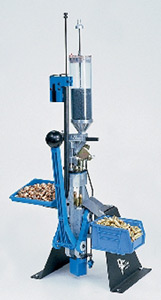- 01: Introduction
- 02: History
- 03: Propellants, Firearms, and Ammunition Development
- 04: Modern Firearms Manufacture
- 05: Small Arms Ammunition
- 06: Evidence Handling Procedures
- 07: Equipment and Instrumentation
- 08: Examination of Firearms
- 09: Cartridge and Shotshell Examination
- 10: Characterization and Evaluation of Fired Projectiles
- 11: Bullet Comparison and Identification
- 12: Gunshot Residue and Distance Determination
- 13: Toolmark Identification
- 14: Communicating Results
- Resources


Cartridge Cases
Home > Cartridge and Shotshell Examination > Fired Case Examination > Examination Challenges > Cartridge Cases

Handloader for pistol amunition
Reloaded Cartridge Cases
Marks on reloaded cartridges may contain unique and reproducible microscopic characteristics, specifically, striated and impressed toolmarks. However, they are identifiable with the reloading tools that made the marks, not with the firearm that fired the cartridge case. These marks may also be inconsistent as a result of the lack of quality control associated with reloaded ammunition.
Reloading toolmarks may result from the following:
- Cartridge case holding tools: These tools physically grip cartridge cases by the base while in a reloading press.
- Resizing tools: These tools are used to compress fired cases which were slightly expanded during obturation back to their precise original dimensions.
- Crimping tools: These tools are used to slightly crimp the mouth of cartridge cases to bullets in some loads.

Click here to view how cartridge cases can be reloaded courtesy of Hornady Manufacturing, Inc.
Ammunition Manufacture or Assembly Factors
- Manufacturing marks on primers: Repetitive marks may be noted on the surface of fired primers. These are actually due to the processes for manufacturing primers and have nothing to do with the discharge of a firearm. These marks will almost never remain in the same relationship to the class characteristics left on the fired cartridge. Manufacturing marks can also be distinguished by the fact that they often extend into a firing pin impression.

Bunter Marks on two Remington
brand 12-gauge shotshells
- Bunter marks: These are marks made by the die which produces the headstamp on rimfire cartridge cases or the headstamp and primer pocket on centerfire cartridge cases. These marks have nothing to do with marks produced by a firearm, but they do allow an examiner to state that two headstamps were produced by the same die.
Only research in a given case will determine how much or how little significance attaches to such an identification. This is normally done on an exceptional basis when all other avenues have been exhausted as far as establishing an association between two cartridge cases or shotshell cases.
This is not the method of choice for relating cartridge cases and shotshell cases to a single source.




